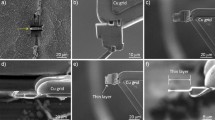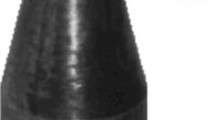Abstract
The microstructural characteristics of nickel-based polycrystalline superalloy GH4037 turbine blades that have been in service for 1600 h have been studied by transmission electron microscopy. In particular, emphasis has been placed on paired dislocations and their interactions with γ′ precipitates. Paired dislocations are universal and coexist with Orowan loops occasionally. The attractive force due to anti-phase boundary energy and the repulsive force between two 1/2<110> dislocations act on paired dislocations simultaneously, causing different morphologies of edge dislocations. Since the shear stress required by paired dislocations to cut through γ/γ′ structure is much lower than Orowan stress of single matrix dislocation, the major formation mechanism is dislocation pairing. A large number of paired dislocations slipping on the same {111} plane can form slip band and can shear off γ′ particles, which may directly lead to the formation of microcracks.







Similar content being viewed by others
References
T.M. Pollock and S. Tin, Nickel-Based Superalloys for Advanced Turbine Engines: Chemistry, Microstructure and Properties, J. Propuls. Power, 2006, 22(2), p 361–374
R.C. Reed, The Superalloys Fundamentals and Applications, 1st ed., Cambridge University Press, New York, 2006
J. Lankford and S.J. Hudak, Jr., Relevance of the Small Crack Problem to Lifetime Prediction in Gas Turbines, Int. J. Fatigue, 1987, 9(2), p 87–93
Z. Mazur, A. Luna-Ramirez, J.A. Juarez-lslas, and A. Campos-Amezcua, Failure Analysis of a Gas Turbine Blade Made of Inconel 738LC Alloy, Eng. Fail. Anal., 2005, 12(3), p 474–486
T.J. Carter, Common Failures in Gas Turbine Blades, Eng. Fail. Anal., 2005, 12(2), p 237–247
E. Poursaeidi, M. Aieneravaie, and M.R. Mohammadi, Failure Analysis of a Second Stage Blade in a Gas Turbine Engine, Eng. Fail. Anal., 2008, 15(8), p 1111–1129
C.J. McMahon, Jr., On the Mechanism of Premature In-Service Failure Nickel-Base Superalloy Gas Turbine Blades, Mater. Sci. Eng., 1974, 13(3), p 295–297
J.T. Guo, Materials Science and Engineering for Superalloys, 1st ed., Science Press, Beijing, 2008 (in Chinese)
Editorial Committee of China Aeronautical Materials Handbook, China Aeronautical Materials Handbook, 2nd ed., China Standards, Beijing, 2002 (in Chinese)
L.M. Brown and R.K. Ham, Strengthening Mechanisms in Crystals, 1st ed., Applied Science, London, 1971
M.P. Jackson and R.C. Reed, Heat Treatment of UDIMET 720Li: The Effect of Microstructure on Properties, Mater. Sci. Eng., 1999, A259(1), p 85–97
W. Huther and B. Reppich, Interaction of Dislocation with Coherent, Stress-Free, Ordered Precipitates, Z. Metall., 1978, 69(19), p 628–634
A. Shyam and W.W. Milligan, A Model for Slip Irreversibility, and Its Effect on the Crack Propagation Threshold in a Nickel-Base Superalloy, Acta Mater., 2005, 53(3), p 835–844
E. Nembach, K. Suzuki, M. Ichihara, and S. Takeuchi, In-Situ Deformation of the Gamma Prime Hardened Superalloy Nimonic PE16 in High-Voltage Electron Microscopes, Philos. Mag., 1985, A51(4), p 607–618
B. Reppich, Some New Aspects Concerning Particle Hardening Mechanisms in γ′ Precipitating Ni-Base Alloys—I. Theoretical Concept, Acta Metall., 1982, 30(1), p 87–94
B. Reppich, P. Schepp, and G. Wehner, Some New Aspects Concerning Particle Hardening Mechanisms in γ′ Precipitating Ni-Base Alloys—II. Experiments, Acta Metall., 1982, 30(1), p 95–104
F. Sun, S. Zhang, S.G. Tian, J.X. Zhang, and H. Harada, Large Stress Concentrations Around Micropore Near a Crack-Tip Induced Deformation Twinning in Ni-Based Single Crystal Superalloy, J. Alloy. Compd., 2014, 586(15), p 479–484
S. Nategh and S.A. Sajjadi, Dislocation Network Formation During Creep in Ni-Base Superalloy GTD-111, Mater. Sci. Eng., 2003, A339(1-2), p 103–108
A.K. Singh, N. Louat, and K. Sadananda, Dislocation Network Formation and Coherency Loss Around Gamma-Prime Precipitates in a Nickel-Base Superalloy, Metall. Trans., 1988, A19(12), p 2965–2973
J.P. Hirth and J. Lothe, Theory of Dislocations, 2nd ed., Wiley, New York, 1982
J.E. King, Fatigue Crack Propagation in Nickel-Base Superalloys—Effects of Microstructures, Load Ratio, and Temperature, Mater. Sci. Technol., 1987, 3(9), p 750–763
K.S. Chin, J.E. Hack, and G.R. Leverant, Fatigue Crack Propagation in Ni-Base Superalloy Single Crystals Under Multiaxial Cyclic Loads, Metall. Trans., 1986, A17(10), p 1739–1750
M. Petrenec, K. Obrtlik, and J. Polak, Inhomogeneous Dislocation Structure in Fatigued INCONEL 713LC Superalloy at Room and Elevated Temperatures, Mater. Sci. Eng., 2005, A400-401(25), p 485–488
Acknowledgments
This work was supported by the National Natural Science Foundation of China (Grant No. 50971078, No. 51071096, No. 51271097, and No. 50671015), Shandong Province Natural Science Foundation (Grant No. ZR2010EM009), China Postdoctoral Science Foundation (special grade, Grant No. 201003630), and the National Basic Research Program of China (No. 2010CB631201).
Author information
Authors and Affiliations
Corresponding author
Rights and permissions
About this article
Cite this article
Lv, X., Sun, F., Tong, J. et al. Paired Dislocations and Their Interactions with γ′ Particles in Polycrystalline Superalloy GH4037. J. of Materi Eng and Perform 24, 143–148 (2015). https://doi.org/10.1007/s11665-014-1307-y
Received:
Revised:
Published:
Issue Date:
DOI: https://doi.org/10.1007/s11665-014-1307-y




